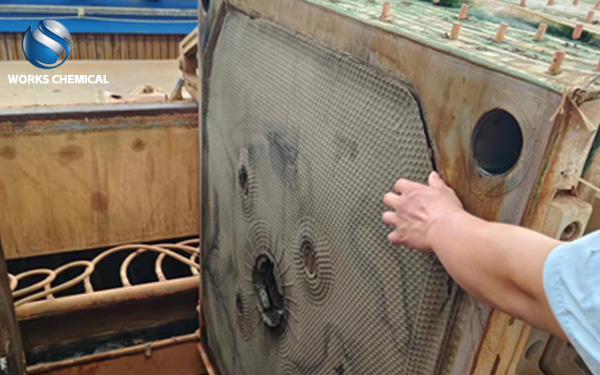
In the field of sludge treatment, choosing the appropriate chemicals is crucial for achieving efficient dewatering and reducing treatment costs. Sludge enhancers and common dewatering agents are two common types of products on the current market. They have significant differences in terms of composition, effect, application scope, etc. However, sludge enhancers demonstrate unique advantages in many aspects.

Composition differencesCommon dewatering agents: There are various types of common dewatering agents, including lime, iron salts, aluminum salts, and some organic flocculants. Lime mainly regulates the pH value of sludge to cause the sludge particles to coagulate. However, its use will lead to an increase in the amount of sludge and make subsequent disposal more difficult, as the addition of lime will enhance the alkalinity of the sludge. Iron and aluminum salts such as polyaluminium chloride and ferrous sulfate, through hydrolysis to produce polynuclear hydroxyl complexes, undergo electro-neutralization and adsorption bridging effects with sludge particles, achieving the flocculation and sedimentation of sludge. However, these agents may introduce new metal ions during use, posing potential hazards to the environment. Moreover, their dewatering effect on sludge is limited, making it difficult to achieve deep dewatering. Some organic flocculants, such as polyacrylamide, although they have good flocculation effects, have uneven product stability and poor adaptability to sludge with certain special properties.
Sludge enhancer: The composition of sludge enhancers is more complex and scientific. Its main components include inorganic compounds, sludge surface structure modifiers, degreasing agents, cell wall disruptors, sludge surface treatment agents, sludge stripping agents, etc. Inorganic compounds play a fundamental role in chemical reactions within it, capable of reacting with specific substances in the sludge to alter its properties. Sludge surface structure modifiers can precisely adjust the surface structure of sludge particles, reduce surface load and specific surface area, and create favorable conditions for the subsequent dewatering process. Degreasing agents are specifically designed to remove the oil components in sludge, as the presence of oil can significantly affect the dewatering performance of sludge. The cell wall disruptor destroys the microbial cell structure in the sludge, releases the water within the cells, and enhances the dehydrability of the sludge. The surface treatment agent and stripping agent for sludge work in synergy, altering the interaction mode between sludge particles and promoting their aggregation and sedimentation.
Differences in effect
Dewatering rate: Although common dewatering agents can reduce the moisture content of sludge to a certain extent, they usually find it difficult to lower the moisture content of sludge to a relatively low level. For instance, the moisture content of sludge treated with lime and traditional flocculants is often only reduced to around 70% to 80%. Compared with subsequent disposal methods such as landfill and incineration, there are still relatively high costs and environmental risks. The sludge enhancer, in combination with equipment such as plate and frame sludge presses, can reduce the moisture content of sludge from over 90% to 40%-60%, achieving deep dewatering. This significantly reduces the volume of sludge and lowers the difficulty and cost of subsequent disposal.
Equipment operation efficiency: During the use of common dewatering agents, due to their limited dewatering effect, they may require a longer processing time and higher operating pressure. This not only increases the energy consumption of the equipment but also easily leads to wear and blockage of the equipment. For instance, during the operation of a filter press, the use of common dewatering agents may cause the filter cloth to clog frequently, requiring frequent cleaning or replacement of the filter cloth, which increases equipment maintenance costs and downtime. In contrast, sludge enhancers can increase the sludge pressing rate of mechanical equipment by 100% to 500% and shorten the sludge pressing cycle. After being conditioned with sludge enhancer, the sludge can achieve solid-liquid separation more quickly when entering the filter press, and the clogging of the filter cloth is significantly reduced, which extends the service life of the filter cloth and improves the overall operating efficiency of the equipment.
Impact on subsequent disposal: The use of common dewatering agents may have an adverse effect on the subsequent disposal of sludge. The extensive use of lime enhances the alkalinity of sludge, which will affect the quality of products in the process of sludge resource utilization, such as brick-making and composting. The amount of sludge enhancer added is small, it does not corrode the equipment, and is conducive to the subsequent disposal methods of sludge such as incineration, brick-making, and composting. The sludge treated with sludge enhancers has more stable properties, a reduced content of harmful substances, and is more suitable for resource utilization, which meets the requirements of environmental protection and sustainable development.
Differences in application scope
Common dewatering agents: The application scope of common dewatering agents is relatively narrow, and their adaptability to water quality and sludge properties is limited. For instance, the effectiveness of some traditional flocculants is greatly reduced when dealing with sludge produced from wastewater with strong acidity or alkalinity. Moreover, for sludge containing special pollutants such as high-concentration heavy metals and refractory organic matter, ordinary dewatering agents often fail to achieve the desired treatment effect.
Sludge enhancer: Sludge enhancers have a wide range of applications. It has strong adaptability to water quality and high tolerance to acids and alkalis. Whether it is sludge produced by domestic sewage or industrial wastewater sludge from various industries such as printing and dyeing, papermaking, electroplating, chemical engineering, and leather, it can play a good role. It is particularly suitable for sludge conditioning before dewatering by plate and frame dewatering equipment, and can effectively improve the dewatering performance of different types of sludge according to their characteristics.